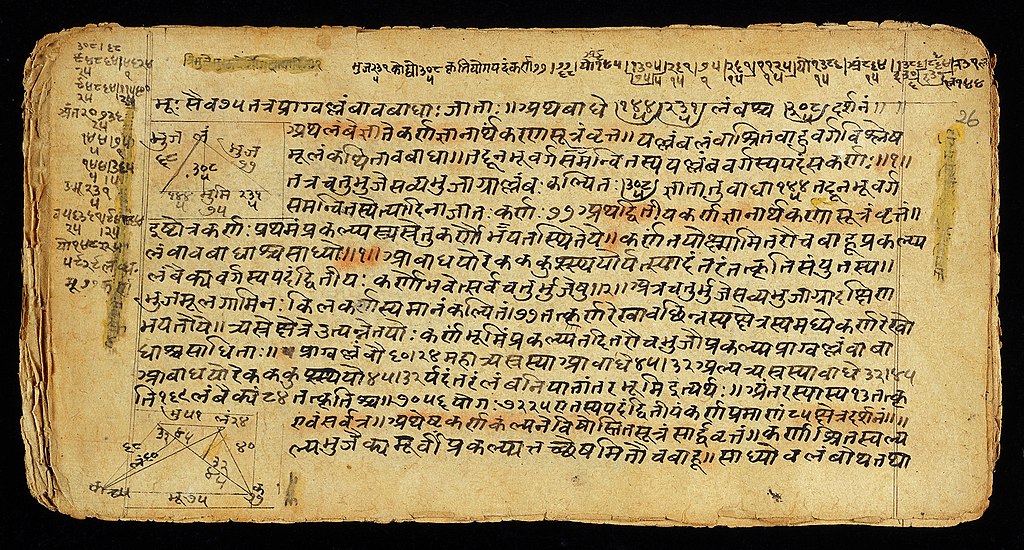
Ancient Indian mathematics texts are a treasure trove of knowledge.
Date : 18/05/2024

पार्थ: कर्णवधाय मार्गणगणं क्रुद्धो रणे संदधे
तस्यार्धेन निवार्य तच्छरगणं मूलैश्चतुभिर्हयान् |
शल्यं षड्भिरथेषुभिस्त्रिभिरपि च्छत्रं ध्वजं कार्मुकम्
चिच्छेदास्य शिरः शरेण कति ते यानर्जुनः संदधे || ७६ ||
Arjuna became furious in the war and, in order to kill Karna, picked up some arrows. With half of these arrows, he destroyed all of Karna's arrows. He killed all of Karna's horses with four times the square root of the arrows. He destroyed the spear with 6 arrows. He used one arrow each to destroy the top of the chariot, the flag, and the bow of Karna. Finally, he cut off Karna's head with another arrow. How many arrows did Arjuna discharge?
This is not a verse from Mahabharata, it is a problem from Bhaskaracharya’s (Bhaskaracharya II) (Born 1114 AD) book Lilavati. Bhaskaracharya had composed this book in 1150 AD to teach Mathematics to his daughter Lilavati, after whom the book is named. This book which is written entirely in verse covers arithmetic, algebra, geometry, mensuration, combinatorics, number theory and other basic topics. This book was used as a standard textbook for almost 700 years.
Now, coming back to the given problem, how does one solve a quadratic equation (polynomial equation with degree 2)? Bhaskaracharya has provided us with a method to solve quadratic equations in the given verse:
गुणध्नमूलोनयुतस्य राशेर्दृष्टस्य युक्तस्य गुणार्धकृत्या ।
मूलं गुणार्धेन युतं विहीनं वर्गीकृतं प्रष्टुरभीष्टराशिः ॥ ७१ ॥
We are given,
and, we are required to find x2.
Add b2/4 on both the sides of the equation to complete the square.
Let,
Therefore, now have
Let us now take square roots of both the sides
Bhaskaracharya had only considered positive values of x, hence he only took positive roots of p2. Hence, we have
Remember we are required to find the value of x2. Therefore
This method of solving quadratic equations is known as "By completing the square method".
Let us use this method to solve the given problem:
Let the number of arrows used by Arjuna be x2.
He used half of these arrows to destroy Karna's arrows, that is, x2/2.
He killed all of Karna's horses with four times the square root of these arrows, that is, 4x.
He destroyed the spear with 6 arrows. He used one arrow each to destroy the top of the chariot, the flag and Karna's bow. And finally, with the last arrow he cut off Karna's head.
We have,
Thus, Arjuna had used 100 arrows to win the fight.
Bhaskaracharya's Lilavati, as also other ancient Indian Mathematics books contained similiar interesting and applied problems. Examples were taken from things that people used to encounter in their daily lives, so that they can relate to it.
Let us look at two more interesting problems on quadratic equations from Lilavati.
यातं हंसकुलस्य मूलदशकं मेघागमे मानसं
प्रोड्डीय स्थलपद्मिनिवनमगादष्टांशकोऽम्भस्तटात् |
बाले बालमृणालशालिनि जले केलिक्रियालालसं
दृष्टं हंसयुगत्रयं च सकलां यूथस्य संख्यां वद ॥ ७५ ॥
A flock of swans used to stay near a lake full of beautiful lotuses. As the clouds gathered, 10 times the square root of the swans went to Manasa (मानस) lake, and one-eighth flew away to a garden of Hibiscus flowers. The remaining three amorous couples played about in the water. O young woman (Lilavati), how many swans were there in that lake?
Let x2 be the number of swans in that lake with beautiful lotuses.
Hence, we have
Thus, 144 swans lived near the lake.
अलिकुलदलमूलं मालतीं यातमष्टौ
निखिलनवमभागाश्चालिनी भृंगमेकम् |
निशि परिमललुब्धं पद्ममध्ये निरुध्दम्
प्रतिरणति रणन्तं ब्रूहि कांतेऽलिसंख्याम् ॥ ७७ ॥
From a group of black bees, square root of the half of them went to the malati tree. Again 8/9th of the bees went to the malati tree. Of the remaining two, one got caught in a lotus whose fragrance captivated him; he started wailing and his beloved responded. Then, O beloved, how many bees were there?
Let the number of black bees be 2x2. Hence, we have
Thus, there were 72 bees in the group.
Ancient Indian mathematics texts are a treasure trove of knowledge in an interesting format.
Image: Lilavati by Bhaskara via Wikimedia
Tags :
It is very interesting to learn how the solution is arrived for the question given using algebra.
Chandrahas: Great initiative indeed. If you consider starting a global-class room, I would like to be of help!
Note: Your email address will not be displayed with the comment.
Very interesting. Plz connect , it would be interesting to interact on topic of mathematics